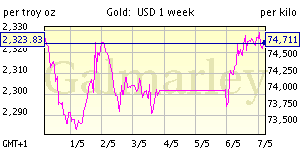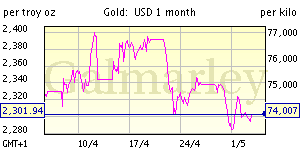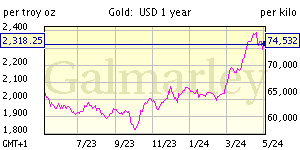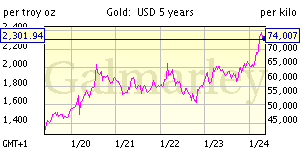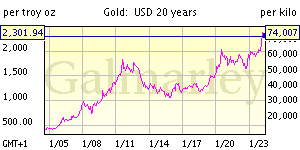By Jeff Clark, BIG GOLD
CPM Group recently released their 2011 Gold Yearbook, an invaluable resource for us gold analysts. Mostly a reference book, even a gold enthusiast might find it dry reading. But I loved it, and as I studied it on a plane, I kept finding data that made me perk up.
To have a little fun with it, I thought I’d summarize what I read in the form of a quiz. See how many you can get correct. Regardless of your score, I’m sure you’ll agree with the ramifications each point makes for the gold market.
I’ll start off easy…
1) The main driver behind rising gold prices over the past decade is:
a) Increased jewelry demand in India
b) Greater industrial uses of the metal
c) Investment demand
b) Greater industrial uses of the metal
c) Investment demand
→Five exchanges began trading gold contracts for the first time in 2010, and three more introduced mini contracts, collectively the largest number launched since the early ‘80s. There are now 24 gold vending machines in seven countries, with three more countries adding machines this year.
Households in developing countries are now moving away from gold jewelry and buying coins and bars for their savings. I could go on, but suffice it to say that investment demand will continue to be very strong.
2) True or false: recovery from gold scrap was lower in 2010 than 2009.
→This is significant because gold prices were higher, which would normally increase the amount of scrap coming to market. One of the primary reasons scrap dropped is because investors are holding on to their metal, reportedly because they believe prices are headed higher. Isn’t that one reason you’re holding on to your bullion?
3) There are many reasons investors have been buying gold over the past 10 years, but what is the #1 reason?
a) Safe-haven asset
b) Gold coins and bars have become more intricate, widespread, and beautiful
c) Supply and demand imbalance
b) Gold coins and bars have become more intricate, widespread, and beautiful
c) Supply and demand imbalance
→High levels of investment buying are expected to continue in 2011 because virtually none of the economic, political, and monetary concerns have been resolved.
If you got all three answers correct, you’re an investor who understands the basic reasons for owning gold and that those reasons are still in play.
Now let’s step it up a little…
4) Gold represented what percent of global financial assets at the end of 2010?
a) 3.1%
b) 0.7%
c) 1.6%
d) 2.4%
The estimated value of investor gold holdings stood at $1.5 trillion at the end of last year, about 0.7% of global financial assets.b) 0.7%
c) 1.6%
d) 2.4%
→While up nine years in a row and triple what it represented in 2001, gold is still a miniscule portion of the world’s private wealth. It represented 2.8% of global assets in 1980, four times what it does today.
5) How many central banks increased their gold holdings in 2010?
a) 9
b) 12
c) 15
d) 19
b) 12
c) 15
d) 19
→It’s interesting that most purchases were from developing countries, unsurprising when you consider they’ve accumulated over $5 trillion in foreign exchange reserves just since 2002.
6) Compared to 2009,U.S. Mint gold coin sales in 2010 were:
a) Down 12%
b) Up 8%
c) Up 5%
d) Up 3%
b) Up 8%
c) Up 5%
d) Up 3%
→Supply problems continue to plague the U.S. Mint, evidenced by the fact that Buffalo sales were suspended for half the year.What happens when the greater population begins to clamor to buy gold? Bottleneck, meet desperation.
7) CPM estimates that the fiscal and monetary imbalances, especially in developed countries, could take how long to resolve?
a) 1 year
b) Decades
c) 5 years
d) 2 years
b) Decades
c) 5 years
d) 2 years
→This sobering fact means gold will likely be in a bull market for many years to come. There are very few options to deal with the overwhelming debt burden in most of these countries: raise taxes, cut spending, increase growth, or print money. Guess which one is most likely? Inflation from currency dilution is baked in the cake and will spur further gold demand and light a fire under the price.
If you got these four questions correct, I think it means you’re an astute investor who doesn’t worry about day-to-day price fluctuations and instead focuses on owning enough ounces to protect your assets from the huge and intractable fiscal problems that still have to be faced.
This data clarifies and confirms why many investors own gold and continue buying it. It paints a decidedly bullish picture for the metal, in spite of record price levels. Monetary issues are far from over, won’t be easily resolved, and will take years to play out. Banks continue buying, and investors aren’t selling. The U.S. Mint can’t keep up with demand, and yet gold is underowned when compared to other major asset classes. Costs are rising for the producers, but margins are rising faster for the better-run companies.
When looking at the big picture for gold, I for one draw comfort from knowing I’ve got some ounces tucked away. I hope you, too, see gold for what it is – protection against unsustainable fiscal imbalances and massive currency debasement, and a profit center for years to come.
![[Most Recent Quotes from www.kitco.com]](http://www.kitconet.com/images/quotes_7a.gif)

